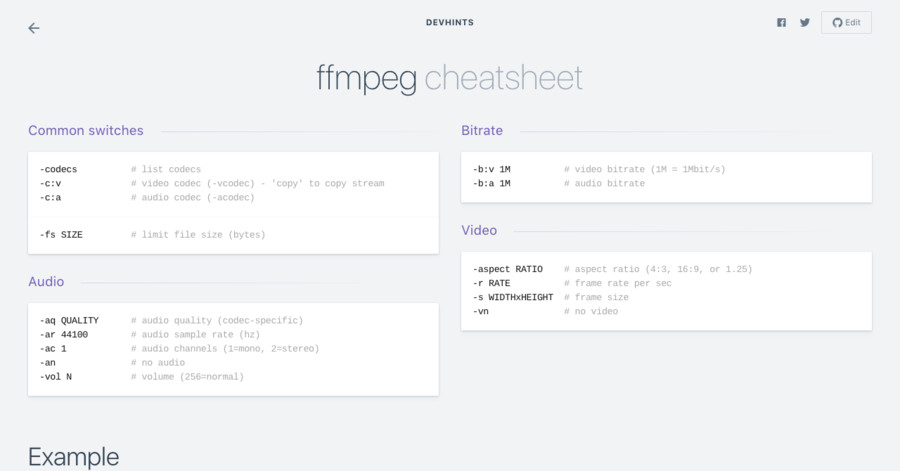

But the code below includes the video download from YouTube. The following command will create one thumbnail image every 10 second.,This is not much different from previous samples.


The drawback is that it will also finish the seeking at some keyframe, not necessarily located at specified time (00:00:18.123), so the seeking may not be as accurate as expected.,Now, we want to extract thumbnails periodically. 0 Seems stream 1 codec frame rate differs from container frame rate: 59.83 (29917/500) -> 29.92 (29917/1000) Input 0, mov,mp4,m4a,3gp,3g2,mj2, from hello. It can also retrieve information about the media file, such as duration, bit rate, frame rate, format, dimensions, display aspect ratio, pixel aspect ratio. The input will be parsed using keyframes, which is very fast. Adjusting frame rate and bitrate are two crude but effective techniques for affecting media quality. If you want to set custom sizes in FFmpeg, please remember that the width parameter ( 1280) comes before height ( 720 ). from Seeking with FFmpeg.,If the -ss comes before -i, it will also produce one image frame (yosemite.png) somewhere around the 18 seconds from the beginning of the movie. To return raw video outputs from the ABR ladder, use the xvbmconvert filter to copy the frames from the device to the host and convert them to AV frames. ffmpeg -i input.mkv -c:a copy -s 1280x720 output.mkv This produces the exact same output as the earlier command. The bigger the seeking time is, the longer you will have to wait. The advantage is that we'll get the frame at the right time, but the drawback is that it will take a lot of time until it finally reaches that time point. The issue is that this results with segments. ffmpeg -ss 100 -t 100) it will output a video with a duration of 100.
#Ffmpeg copy frame size mp4#
This will be done very slowly, frame by frame. FFmpeg codec frame size is not set and audio longer than video I just found out about FFmpeg and I need it to cut loads of MP4 files to the last 20 seconds of each. I've noticed that for some video sources with a (constant) frame-rate of 29.97 it'll output a video with a duration of 100.0 frames instead of the expected 1. In this case, the input will be decoded until it reaches the position given by -ss. However, in our example, since we did put -ss after -i, it produced one image frame precisely at the requested time from the beginning of the movie. Gray = cv2.cvtColor(frame, cv2.COLOR_BGR2GRAY) Writer = WriteGear(output_filename = 'Output.mp4', compression_mode = True, logging = True, ** output_params) #Define writer with output filename 'Output.mp4' Stream = cv2.VideoCapture(0) #Open live webcam video stream on first index(i.e.0) device Stream #0.#define(Codec, CRF, preset) FFmpeg tweak parameters Seems stream 0 codec frame rate differs from container frame rate: 1000.00 (1000/1) -> 15.00 (15/1) Estimating duration from bitrate, this may be inaccurate St:0 removing common factor 1000000 from timebase Format matroska,webm probed with size=2048 and score=100 Using the attached blank.jpg as a starting point to loop and produce a valid webm file with a frame rate of 15, the resulting copy command will produce a file with an incorrect codec frame rate of 1000.įfmpeg -v 9 -loglevel 99 -y -loop 1 -vframes 225 -r 15 -i blank.jpg -f webm -vcodec libvpx blank.webmįfmpeg -v 9 -loglevel 99 -y -i blank.webm -vcodec copy -f webm blank_copy.webmįfmpeg -v 9 -loglevel 99 -i blank_copy.webmįfmpeg version N-32325-g6f8b1fc, Copyright (c) 2000-2011 the FFmpeg developersĬonfiguration: -enable-gpl -enable-libfaac -enable-libmp3lame -enable-libopencore-amrnb -enable-libopencore-amrwb -enable-libtheora -enable-libvorbis -enable-libx264 -enable-libxvid -enable-nonfree -enable-postproc -enable-version3 -enable-x11grab -enable-libvpx -prefix=/tmp


 0 kommentar(er)
0 kommentar(er)
